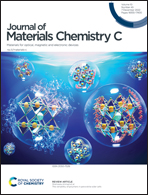Photovoltaic memristors based on photoelectric synaptic plasticity of a bulk photovoltaic effect device†
Abstract
Memristors, with a synaptic plasticity similar to biological synapses, are recognized as one of the key devices to achieve computing in memory and overcome the Von Neumann bottleneck. Herein, we developed a photovoltaic memristor based on a bulk photovoltaic effect (BPVE) device, where its photovoltaic synaptic plasticity learning property is related to the kinetics of domain switching in ferroelectric films. With the pre (post)-double pulse modeled as the pre (post)-potential of the biological synapse, the photovoltaic synaptic plasticity of the BPVE device is investigated using piezoelectric atomic force microscopy and conductive atomic force microscopy. Under 800 cycles of facilitation and depression, the BPVE device demonstrates highly recognizable photovoltaic response variances, which can be continuously modulated from low to high photovoltaic responses. Spike-timing-dependent plasticity can also be harnessed from the kinetics of domain switching under different patterns of a double pulse. Based on the BPVE device, the photovoltaic memristor adopts a light signal reading mode instead of a high-frequency electrical signal, which further improves the reading speed and reduces the power consumption of the memristor device.



 Please wait while we load your content...
Please wait while we load your content...